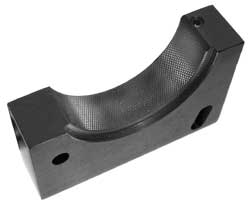|
|
|
Replacement Back Plate for PCM-2
|
| |

|
Quantity in Basket:
None
Catalog No.: PCM-P
Price: $214.00
Shipping Weight: 2.00 pounds
Sorry, we are no longer taking orders for the Replacement Back Plate for PCM-2 on our legacy website. Please visit our new website at Corbins.com for all future orders. Any question/concerns you can reach us at sales@corbins.com Thank you
|
| |
This is the half-moon arc steel back plate that mounts on
top of the PCM-2 power cannelure machine. The space
between this back plate curve and the various diameters of
PCM-W cannelure wheels makes it possible to use the same
machine for a wide range of bullet diameters, and to adjust
the depth of the cannelure precisely.
The plate mounts to the top of the cannelure machine with
two hardened cap screws, which in turn pass through holes
in the plate that have clearance to allow precise position
of the plate in relation to the wheel. One side of the
plate has an adjusting set screw to push against the
right side cap screw, and determines how wide the gap
or arc path can be. Another set screw at right angles to
the adjustment screw locks it in place. The bullet pushes
against the back plate as it passes through the arc, and
the plate is held from moving away by the end of the
adjustment set screw.
The easy way to set up the plate for a given caliber or
depth of cannelure is to determine the bullet diameter at
the desired cannelure depth, and place two pins or previously
cannelured bullets at the start and at the end of the arc,
with the correct diameter (caliber) of wheel installed.
If using previously cannelured bullets as a guide, the
cannelure on the bullets must be engaged in the raised
embossing ring on the cannelure wheel.
Push the back plate toward the wheel so that both pins or
bullets are firmly engaged by the embossing ring, thereby
positioning both ends of the plate at the desired distance
from the wheel. It is best if the two pins or bullets are
placed about 1/2 inch inside the arc of the plate, rather
than exactly at the ends.
While holding firm pressure on the back of the plate, tighten
both of the cap screws. If the place cannot be moved
close enough to engage the pin or bullet on the right side,
back off the adjustment set screw to allow this to happen.
Test the setting with two or three bullets, and check the
height, depth, and evenness of the cannelure ring applied
to the bullets. If the bullet does not move through the
track and emerge on the right end, adjust the plate position
slightly by loosening the cap screws a small amount and
using the adjustment set screw to move the right end to
a position which provides the best and most even cannelure.
Try to avoid overly-deep cannelures, as the more metal is
displaced, the more likely the bullet will become oversized
from displacement of additional material. Some commercial
operations use only .001-.002 inch cannelures, but the
average cannelure depth is closer to .010 inches. Bullet
casters are used to .030 or more depth, sometimes .100-.150
inch grooves, but that is to hold lubricant. Jacketed
bullets use the cannelure as a crimping area, or as
identification. A much more shallow depth works fine
for this.
|
|
































